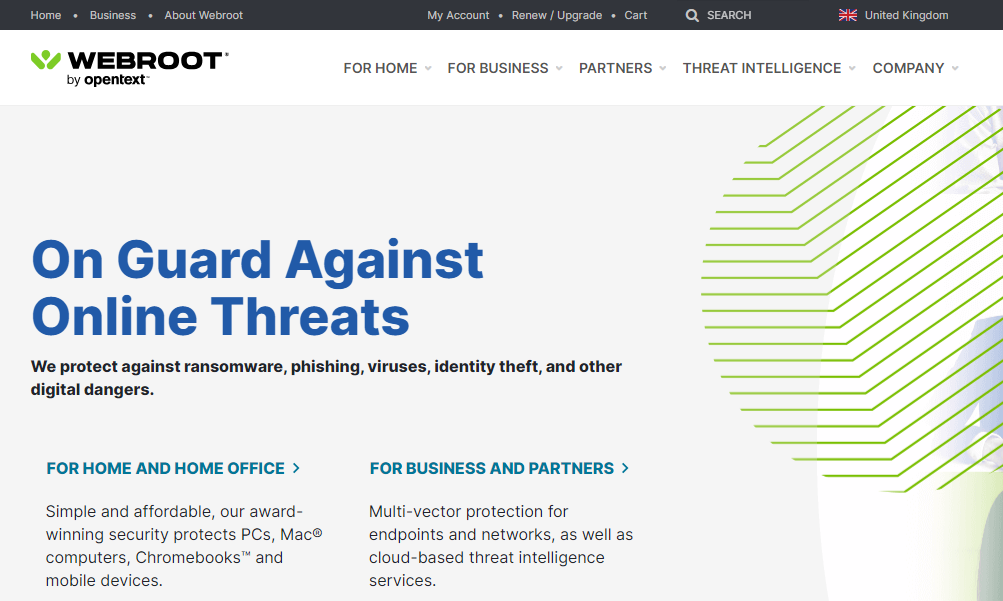
In the realm of digital security, Webroot and McAfee often leave users pondering which path to take in their quest for comprehensive protection. These names stand as stalwarts in the cybersecurity domain, each boasting a repertoire of tools and features aimed at fortifying defences against the relentless onslaught of cyber threats.
The juxtaposition of Webroot and McAfee reveals a fascinating narrative of diverse methodologies and approaches to cybersecurity. Each brand champions a comprehensive suite of protective measures, boasting distinctive features and tools designed to shield users from an array of digital hazards.
This article is a comprehensive exploration into the realms of Webroot and McAfee, dissecting their functionalities, efficiency, user experience, and overall efficacy. Our objective is to provide users with an informed comparison, enabling them to navigate the intricacies of these cybersecurity giants and make well-informed decisions aligning with their specific security requirements.
Join us as we embark on an in-depth journey to unravel the unique offerings, strengths, and limitations of Webroot and McAfee, empowering users to select the cybersecurity solution that best aligns with their digital security needs.
Introduction to Webroot and McAfee Antivirus Software
Webroot is a prominent cybersecurity solution that has carved its niche in the industry for over two decades. Renowned for its lightweight footprint and robust cloud-based security, it offers users a formidable defence against an array of cyber threats. Its approach revolves around cloud-based protection that harnesses the power of artificial intelligence and machine Learning to swiftly identify and mitigate evolving threats.
On the other hand, McAfee, a household name in the realm of cybersecurity, has established itself as a stalwart in the industry. With a legacy spanning multiple decades, it has evolved into a comprehensive suite of security solutions, offering protection against viruses and malware and encompassing layers of defences against a wide spectrum of cyber threats. McAfee employs a combination of signature-based detection, behaviour analysis, and heuristic scanning to safeguard users against an ever-expanding array of threats.
Primary Functions and Features
Webroot and McAfee stand out as two prominent contenders. Each offering a unique blend of features and benefits, these antivirus software cater to the various user needs and preferences. Let’s delve into the primary functions and features of each security solution to understand their strengths and applications.
Webroot
• Cloud-Based Protection: Webroot’s primary function revolves around cloud-based security, ensuring real-time protection from various cyber threats.
• Advanced Threat Intelligence: This software employs sophisticated threat intelligence and behavioural analysis to identify and neutralise potential threats.
• Lightweight Footprint: Known for its minimal impact on system resources, it allows for seamless operation alongside other applications.
McAfee
• Comprehensive Security Suite: McAfee offers a comprehensive suite of security tools encompassing antivirus, firewall, identity protection, and more.
• Multi-Layered Protection: This software utilises a multi-layered approach to security, combining signature-based detection, behavioural analysis, and machine learning.
• User-Friendly Interface: It provides an intuitive user interface with customisable options for a personalised security experience.
Webroot Antivirus Features

Webroot’s reputation for lightweight and efficient protection is well-deserved. Its cloud-based architecture enables real-time threat detection without compromising system performance. Let’s explore the key features that make Webroot a formidable defence against online threats.
Security Features
• Advanced Threat Protection: Webroot’s hallmark is the cutting-edge approach to security. It employs behaviour-based threat detection along with cloud-based analytics to identify and mitigate emerging threats effectively.
• Real-Time Scanning: The antivirus solution operates with real-time scanning, detecting and neutralising potential threats immediately upon identification.
• Phishing and Identity Theft Protection: It offers protection against phishing attacks and safeguards user identity, securing sensitive personal information from theft.
Performance and System Impact
• Lightweight and Low System Impact: Webroot boasts a lightweight footprint, utilising minimal system resources compared to traditional antivirus software.
• Quick Scans and Low Resource Usage: It conducts rapid scans without burdening the system, ensuring comprehensive protection without compromising system performance.
• Effective Malware Removal: In addition to proactive protection, it efficiently removes detected malware with minimal user intervention.
User Interface and Experience
• Simplified Interface: Webroot presents an intuitive and straightforward user interface, ensuring ease of navigation and accessibility for users of varying technical expertise.
• Customisable Settings: It offers customisation options, allowing users to tailor settings based on their preferences and security requirements.
• User-Friendly Experience: The antivirus software is designed for an effortless user experience, streamlining tasks like scheduling scans or adjusting security settings.
McAfee Antivirus Features
McAfee antivirus also stands as a stalwart defender against a wide range of online threats. Its comprehensive suite of features offers robust protection without sacrificing user experience. It combines robust security features, efficient performance, and a user-friendly interface to provide comprehensive protection against a wide array of cyber threats. Let’s examine the key features that make McAfee a powerful protector of your digital assets.
Security Features
• Virus and Malware Protection: McAfee Antivirus offers comprehensive protection against various forms of malware, including viruses, trojans, worms, spyware, and ransomware. Its real-time scanning feature continuously monitors the system for potential threats.
• Firewall Protection: The software includes a robust firewall that helps in monitoring and managing incoming and outgoing traffic, preventing unauthorised access to the system.
• Identity Theft Protection: It provides tools to safeguard personal and financial information, minimising the risks of identity theft and phishing attempts.
Performance and System Impact
• System Resource Usage: McAfee is designed to operate efficiently without significantly impacting system performance. It utilises minimal system resources during scans and updates, ensuring smooth operation while providing continuous protection.
• Malware Detection Effectiveness: The antivirus software is known for its high malware detection rates, effectively identifying and eliminating threats while minimising false positives.
User Interface and Experience
• User-Friendly Interface: McAfee features an intuitive and user-friendly interface, making it accessible for users with varying technical expertise levels. It offers easy navigation and clear options for scans, updates, and settings.
• Customisation Options: Users have the flexibility to customise their antivirus settings, allowing them to tailor the protection level based on their preferences and needs.
• Accessibility: The software provides clear notifications and alerts, ensuring that users are informed about potential threats and necessary actions without causing confusion.

Webroot and McAfee: A Comparative Analysis
Webroot and McAfee stand out for their robust protection and comprehensive features. Let’s delve into a comparative analysis of these two security giants to determine which one best suits your needs.
Security Capabilities
Webroot utilises advanced behavioural analysis and cloud-based intelligence to detect and respond to threats effectively. It employs minimal system resources and provides real-time protection against various forms of malware and online threats.
McAfee offers a comprehensive security suite with multiple layers of protection, including antivirus, firewall, identity theft protection, and more. It uses signature-based and behavioural analysis to detect and mitigate threats efficiently.
• While Webroot specialises in lightweight protection using cloud-based intelligence, McAfee provides a broader range of security features with more comprehensive protection against various threats.
Performance Impact
Webroot is known for its minimal impact on system resources due to its cloud-based approach. It consumes less disk space and operates efficiently even on less powerful devices, ensuring smooth performance during scans.
McAfee may have a moderate impact on system resources during scans and updates. It occasionally requires more system resources due to its comprehensive suite of security features.
• Webroot tends to be lighter on system resources compared to McAfee, making it suitable for devices with lower processing power.
User-Friendliness
Apart from robust security, a user-friendly interface is crucial for a seamless and enjoyable experience. Both Webroot and McAfee strive to provide intuitive and easy-to-navigate interfaces that cater to diverse users. Here’s how their designs and features enhance the user experience.
Webroot offers a clean and straightforward interface with minimal configuration required. It provides easy navigation and setup, suitable for both novice and advanced users.
McAfee provides a user-friendly interface with extensive customisation options. It caters to users who prefer more control over their security settings and offers a wider array of features that might require some familiarity.
• Webroot excels in simplicity and ease of use. McAfee offers more customisation options but might be slightly more complex for beginners. Choose between Webroot and McAfee based on your preferences for system impact, level of customisation, and the depth of security features you require.
Pricing Plans and Subscription Models
Pricing and subscription models play a significant role in the antivirus decision-making process. Webroot and McAfee offer various pricing plans catering to different needs and budgets. Let’s compare their pricing structures, subscription options, and additional features included in each plan to determine which one aligns best with your financial considerations and desired security level.
Webroot
• Pricing Tiers: Webroot offers various subscription options, including plans for individuals, families, and businesses. The prices vary based on the number of devices and the duration of the subscription.
• Value for Money: Webroot’s pricing is competitive, providing affordable packages that cater to different user needs. It offers good value, especially for those seeking basic yet effective antivirus protection.
• Features: Each plan includes core security features like real-time threat protection, identity theft protection, and cloud-based intelligence for threat detection.
McAfee
• Pricing Tiers: McAfee provides diverse subscription options for single or multiple devices, covering various needs, such as antivirus protection, comprehensive security suites, and family plans.
• Value for Money: It offers a broad range of features across different plans, providing good value for users who seek extensive security coverage. The higher-tier plans might offer more features but could be relatively expensive.
• Features: McAfee plans come with advanced features like antivirus, firewall, identity theft protection, VPN, and secure cloud storage.
Comparison: Webroot focuses on providing budget-friendly plans with essential security features, while McAfee offers more extensive security suites with additional utilities that might come at a higher price.
Customer Support and Reliability
Customer support and reliability are paramount when selecting an antivirus solution. Webroot and McAfee both strive to provide exceptional support and maintain high reliability standards. Let’s examine their customer support channels, response times, and overall reputation for dependability to determine which one offers a more satisfying and secure experience.
Webroot
• Customer Support Options: Webroot offers various support channels, including phone support, live chat, and email. The response time is generally quick, and the representatives are knowledgeable and helpful.
• Reliability: Webroot’s customer support is reliable in addressing user queries and issues promptly. Their support team is well-equipped to handle technical problems and provides effective solutions.
McAfee
• Customer Support Options: McAfee provides comprehensive support, including phone, live chat, email, and community forums. Their support is available 24/7, offering assistance to users across different time zones.
• Reliability: McAfee’s customer support is known for its reliability. They are responsive, offer solutions promptly, and have an extensive knowledge base to address a wide range of user queries.
Comparison: Both Webroot and McAfee offer diverse support options, but McAfee stands out with its 24/7 availability, ensuring users receive assistance round the clock.
Unique Selling Points and Key Differences
Let’s explore their unique selling points, key differences, and overall suitability to determine which one best aligns with your specific needs.
Webroot
• Cloud-Based Protection: Webroot utilises cloud-based technology for real-time protection against malware and other online threats. It ensures minimal system resource usage while providing effective security.
• Fast Scanning: It is known for its swift scanning capabilities, performing quick scans without compromising thoroughness. Its scans are non-intrusive and run seamlessly in the background.
McAfee
• Comprehensive Suite: McAfee offers a comprehensive suite with various security features, including antivirus protection, firewall, and identity theft protection, catering to different security needs.
• Performance Optimisation: It optimises system performance with features like file cleanup, performance boosters, and optimisation tools, enhancing overall device performance.
Comparison: Webroot’s standout features include cloud-based protection and rapid scanning, ensuring security without compromising system speed. However, McAfee’s unique offerings lie in its comprehensive security suite and performance optimisation tools, providing a multifaceted approach to cybersecurity and system enhancement.
In Conclusion
Webroot and McAfee offer distinctive strengths. Selecting between them depends largely on individual preferences, emphasising specific features and priorities.
Webroot prioritises efficiency and speed, ensuring that robust security doesn’t come at the cost of system performance. Its cloud-based protection is lightweight and operates in the background, while its rapid scanning thoroughly detects and neutralises threats without bogging down the system.
McAfee stands out for its comprehensive suite of security features, providing a comprehensive defence against various online threats. It offers comprehensive antivirus protection, firewall capabilities, and performance optimisation tools, ensuring that users can access their devices securely and efficiently.
